初中英语时态总结一览表完整版
- 格式:docx
- 大小:195.64 KB
- 文档页数:4
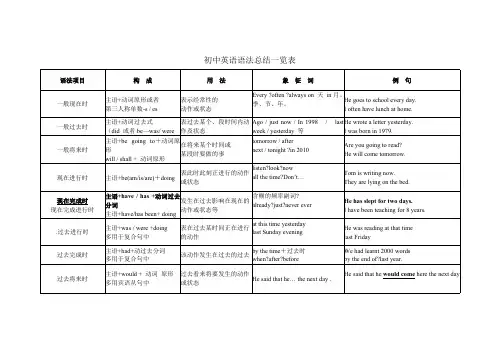
初中英语语法总结一览表语法项目构成用法象征词例句一般现在时主语+动词原形或者第三人称单数-s / es表示经常性的动作或状态Every ?often ?always on 天in月、季、节、年。
He goes to school every day.I often have lunch at home.一般过去时主语+动词过去式(did 或者be—was/ were表过去某个、段时间内动作及状态Ago / just now / In 1998 / lastweek / yesterday 等He wrote a letter yesterday.I was born in 1979.一般将来时主语+be going to+动词原形will / shall + 动词原形在将来某个时间或某段时要做的事tomorrow / afternext / tonight ?in 2010Are you going to read?He will come tomorrow.现在进行时主语+be(am/is/are)+doing 表此时此刻正进行的动作或状态listen?look?nowall the time?Don’t…Tom is writing now.They are lying on the bed.现在完成时现在完成进行时主语+have / has +动词过去分词主语+have/has been+ doing发生在过去影响在现在的动作或状态等含糊的频率副词?already?just?never everHe has slept for two days.I have been teaching for 8 years..过去进行时主语+was / were +doing多用于复合句中表在过去某时间正在进行的动作at this time yesterdaylast Sunday eveningHe was reading at that timelast Friday过去完成时主语+had+动过去分词多用于复合句中该动作发生在过去的过去by the time+过去时when?after?beforeWe had learnt 2000 wordsby the end of?last year.过去将来时主语+would + 动词原形多用宾语从句中过去看来将要发生的动作或状态He said that he… the next day .He said that he would come here the next day.。
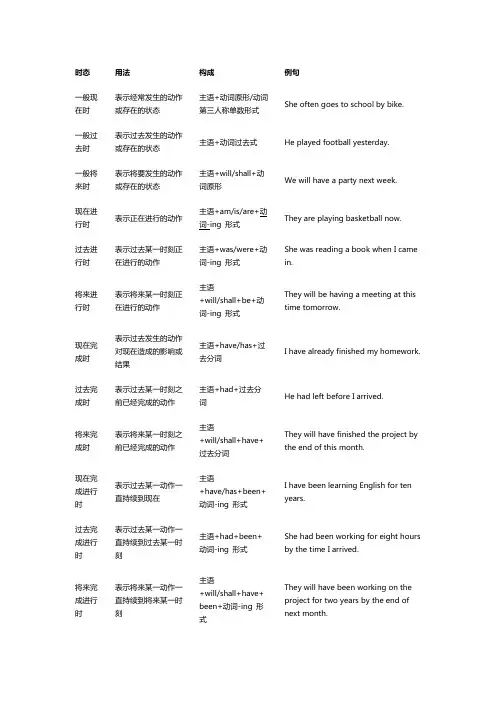
一般现在时表示经常发生的动作或存在的状态主语+动词原形/动词第三人称单数形式She often goes to school by bike.一般过去时表示过去发生的动作或存在的状态主语+动词过去式He played football yesterday.一般将来时表示将要发生的动作或存在的状态主语+will/shall+动词原形We will have a party next week.现在进行时表示正在进行的动作主语+am/is/are+动词-ing 形式They are playing basketball now.过去进行时表示过去某一时刻正在进行的动作主语+was/were+动词-ing 形式She was reading a book when I camein.将来进行时表示将来某一时刻正在进行的动作主语+will/shall+be+动词-ing 形式They will be having a meeting at thistime tomorrow.现在完成时表示过去发生的动作对现在造成的影响或结果主语+have/has+过去分词I have already finished my homework.过去完成时表示过去某一时刻之前已经完成的动作主语+had+过去分词He had left before I arrived.将来完成时表示将来某一时刻之前已经完成的动作主语+will/shall+have+过去分词They will have finished the project bythe end of this month.现在完成进行时表示过去某一动作一直持续到现在主语+have/has+been+动词-ing 形式I have been learning English for tenyears.过去完成进行时表示过去某一动作一直持续到过去某一时刻主语+had+been+动词-ing 形式She had been working for eight hoursby the time I arrived.将来完成进行时表示将来某一动作一直持续到将来某一时刻主语+will/shall+have+been+动词-ing 形式They will have been working on theproject for two years by the end ofnext month.过去将来时表示过去某一时刻之后将要发生的动作主语+would/should+动词原形He said he would come back the nextday.过去将来进行时表示过去某一时刻之后将要进行的动作主语+would/should+be+动词-ing 形式She said she would be working on theproject at that time.过去将来完成时表示过去某一时刻之后将要完成的动作主语+would/should+have+过去分词He said he would have finished thework by the end of the week.。
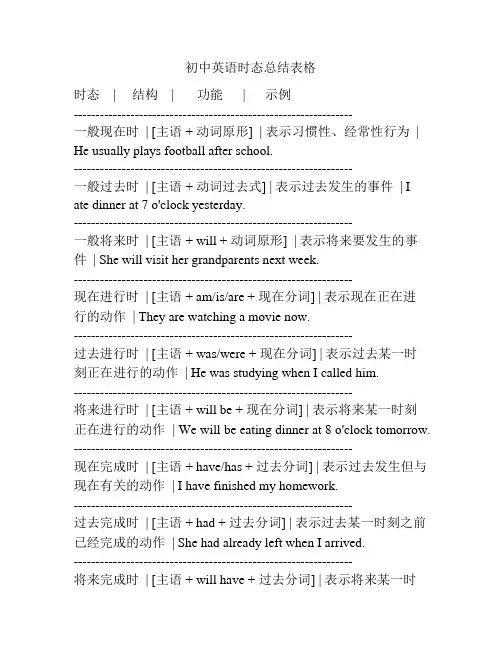
初中英语时态总结表格时态 | 结构 | 功能 | 示例----------------------------------------------------------------一般现在时 | [主语 + 动词原形] | 表示习惯性、经常性行为 | He usually plays football after school.----------------------------------------------------------------一般过去时 | [主语 + 动词过去式] | 表示过去发生的事件 | I ate dinner at 7 o'clock yesterday.----------------------------------------------------------------一般将来时 | [主语 + will + 动词原形] | 表示将来要发生的事件 | She will visit her grandparents next week.----------------------------------------------------------------现在进行时 | [主语 + am/is/are + 现在分词] | 表示现在正在进行的动作 | They are watching a movie now.----------------------------------------------------------------过去进行时 | [主语 + was/were + 现在分词] | 表示过去某一时刻正在进行的动作 | He was studying when I called him.----------------------------------------------------------------将来进行时 | [主语 + will be + 现在分词] | 表示将来某一时刻正在进行的动作 | We will be eating dinner at 8 o'clock tomorrow. ----------------------------------------------------------------现在完成时 | [主语 + have/has + 过去分词] | 表示过去发生但与现在有关的动作 | I have finished my homework.----------------------------------------------------------------过去完成时 | [主语 + had + 过去分词] | 表示过去某一时刻之前已经完成的动作 | She had already left when I arrived.----------------------------------------------------------------将来完成时 | [主语 + will have + 过去分词] | 表示将来某一时刻之前已经完成的动作 | By this time next year, we will have graduated from high school.----------------------------------------------------------------情态动词 | [情态动词 + 动词原形] | 表示能力、意愿、推测等 | She can swim very well.----------------------------------------------------------------。
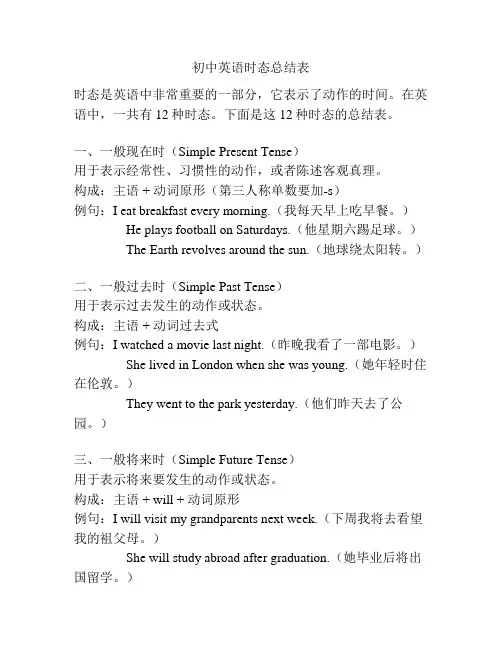
初中英语时态总结表时态是英语中非常重要的一部分,它表示了动作的时间。
在英语中,一共有12种时态。
下面是这12种时态的总结表。
一、一般现在时(Simple Present Tense)用于表示经常性、习惯性的动作,或者陈述客观真理。
构成:主语 + 动词原形(第三人称单数要加-s)例句:I eat breakfast every morning.(我每天早上吃早餐。
)He plays football on Saturdays.(他星期六踢足球。
)The Earth revolves around the sun.(地球绕太阳转。
)二、一般过去时(Simple Past Tense)用于表示过去发生的动作或状态。
构成:主语 + 动词过去式例句:I watched a movie last night.(昨晚我看了一部电影。
)She lived in London when she was young.(她年轻时住在伦敦。
)They went to the park yesterday.(他们昨天去了公园。
)三、一般将来时(Simple Future Tense)用于表示将来要发生的动作或状态。
构成:主语 + will + 动词原形例句:I will visit my grandparents next week.(下周我将去看望我的祖父母。
)She will study abroad after graduation.(她毕业后将出国留学。
)They will have a party on Friday.(他们将在星期五举行一个派对。
)四、现在进行时(Present Continuous Tense)用于表示现在正在进行的动作。
构成:主语 + am/is/are + 现在分词(-ing形式)例句:I am reading a book now.(我现在在读一本书。
)She is playing the piano at the moment.(她此刻正在弹钢琴。
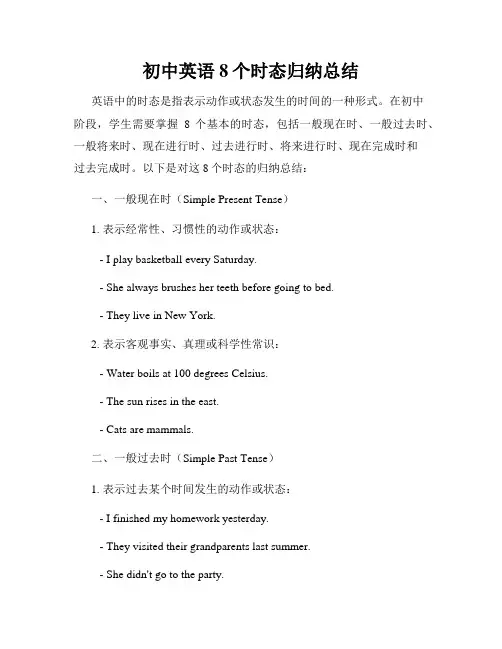
初中英语8个时态归纳总结英语中的时态是指表示动作或状态发生的时间的一种形式。
在初中阶段,学生需要掌握8个基本的时态,包括一般现在时、一般过去时、一般将来时、现在进行时、过去进行时、将来进行时、现在完成时和过去完成时。
以下是对这8个时态的归纳总结:一、一般现在时(Simple Present Tense)1. 表示经常性、习惯性的动作或状态:- I play basketball every Saturday.- She always brushes her teeth before going to bed.- They live in New York.2. 表示客观事实、真理或科学性常识:- Water boils at 100 degrees Celsius.- The sun rises in the east.- Cats are mammals.二、一般过去时(Simple Past Tense)1. 表示过去某个时间发生的动作或状态:- I finished my homework yesterday.- They visited their grandparents last summer.- She didn't go to the party.2. 表示过去的经历或习惯:- When I was young, I often went swimming. - He always ate breakfast at 8 o'clock.三、一般将来时(Simple Future Tense)1. 表示将来要发生的动作或事件:- I will go shopping tomorrow.- They are going to have a picnic next week. - She won't be late for the meeting.2. 表示将来的打算或意愿:- I am going to be a doctor when I grow up.- We will help you with your project.四、现在进行时(Present Continuous Tense)1. 表示现在正在进行的动作:- We are studying English at the moment.- He is playing soccer with his friends.- They aren't watching TV right now.2. 表示现阶段的趋势或变化:- The population is increasing rapidly.- More and more people are using smartphones.五、过去进行时(Past Continuous Tense)1. 表示过去某一时间段内正在进行的动作:- I was reading a book when the phone rang.- They were cooking dinner at 7 o'clock.2. 表示过去的同时发生的两个动作:- She was listening to music while doing her homework.六、将来进行时(Future Continuous Tense)1. 表示将来某一时间段内正在进行的动作:- Tomorrow, they will be flying to Paris.- I will be waiting for you at the station.2. 表示将来的预测或计划:- This time next month, I will be studying for my exams.七、现在完成时(Present Perfect Tense)1. 表示过去某一时间发生的动作对现在造成的影响或结果: - I have finished my homework, so I can watch TV now.- She has already eaten lunch.2. 表示过去某一时间内多次发生的动作:- We have visited that museum several times.八、过去完成时(Past Perfect Tense)1. 表示过去某一时间点之前已经完成的动作:- By the time they arrived, we had already left.- I had finished my work before the deadline.2. 表示过去的顺序或先后关系:- She realized that she had forgotten her keys after she locked the door.以上是初中英语的8个时态的归纳总结。
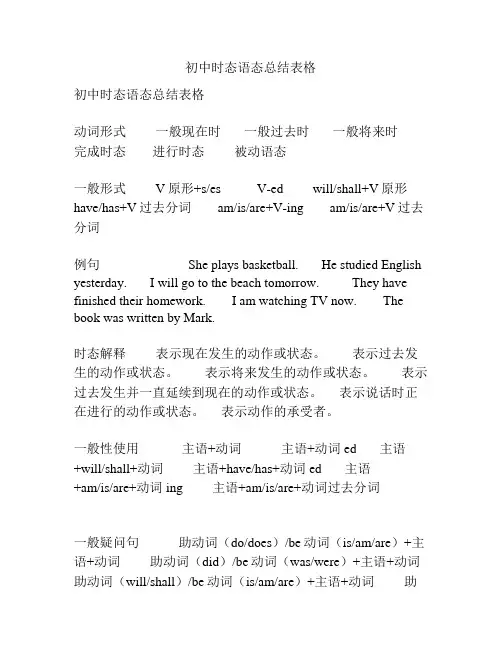
初中时态语态总结表格初中时态语态总结表格动词形式一般现在时一般过去时一般将来时完成时态进行时态被动语态一般形式 V原形+s/es V-ed will/shall+V原形have/has+V过去分词 am/is/are+V-ing am/is/are+V过去分词例句 She plays basketball. He studied English yesterday. I will go to the beach tomorrow. They have finished their homework. I am watching TV now. The book was written by Mark.时态解释表示现在发生的动作或状态。
表示过去发生的动作或状态。
表示将来发生的动作或状态。
表示过去发生并一直延续到现在的动作或状态。
表示说话时正在进行的动作或状态。
表示动作的承受者。
一般性使用主语+动词主语+动词ed 主语+will/shall+动词主语+have/has+动词ed 主语+am/is/are+动词ing 主语+am/is/are+动词过去分词一般疑问句助动词(do/does)/be动词(is/am/are)+主语+动词助动词(did)/be动词(was/were)+主语+动词助动词(will/shall)/be动词(is/am/are)+主语+动词助动词(have/has)/be动词(is/am/are)+主语+动词ed 助动词(am/is/are)/be动词(is/am/are)+主语+ 动词ing 助动词(am/is/are)/be动词(is/am/are)+主语+动词过去分词特殊疑问句疑问词+助动词(do/does)/be动词(is/am/are)+主语+动词疑问词+助动词(did)/be动词(was/were)+主语+动词疑问词+助动词(will/shall)/be 动词(is/am/are)+主语+动词疑问词+助动词(have/has)/be动词(is/am/are)+主语+动词ed 疑问词+助动词(am/is/are)/be动词(is/am/are)+主语+ 动词ing 疑问词+助动词(am/is/are)/be动词(is/am/are)+主语+动词过去分词否定句主语+助动词(do not/does not)/be动词(is/am/are not)+动词主语+助动词(did not)/be动词(was/were not)+动词主语+助动词(will/shall not)/be动词(is/am/are not)+动词主语+助动词(have/has not)/be 动词(is/am/are not)+动词ed 主语+助动词(am not/is not/are not)/be动词(is/am/are not)+动词ing 主语+助动词(am not/is not/are not)/be动词(is/am/are not)+动词过去分词情态动词主语+情态动词+动词原形主语+情态动词+动词原形主语+will/shall+情态动词+动词原形主语+have/has+情态动词+动词原形主语+am/is/are+情态动词+ 动词ing 主语+am/is/are+情态动词+动词过去分词现在进行时主语+am/is/are+V-ing 主语+was/were+V-ing 主语+will/shall+be+V-ing 主语+have/has+been+V-ing - -过去进行时主语+was/were+V-ing -- - - -将来进行时主语+will/shall+be+V-ing -- - - -完成进行时主语+have/has+been+V-ing 主语+had+been+V-ing - -- -被动语态主语+am/is/are+V过去分词主语+was/were+V过去分词主语+will/shall+be+V过去分词主语+have/has+been+V过去分词主语+am/is/are+being+V过去分词主语+am/is/are+V过去分词。

初中英语语法总结一览表语法项目构成用法一般现在时主语 +动词原形或者表示经常性的第三人称单数 -s / es 动作或状态一般过去时主语 +动词过去式表过去某个、段时间内动( did 或者 be—was/ were 作及状态主语 +be going to +动词原在将来某个时间或一般将来时形某段时要做的事will / shall + 动词原形象征词Every ?often ?always on 天季、节、年。
Ago / just now / In 1998week / yesterday 等tomorrow / afternext / tonight ?in 2010例句in 月、He goes to school every day.I often have lunch at home./last He wrote a letter yesterday.I was born in 1979.Are you going to read?He will come tomorrow.现在进行时主语 +be(am/is/are) + doing 表此时此刻正进行的动作或状态现在完成时主语 +have / has + 动词过去发生在过去影响在现在的分词现在完成进行时动作或状态等主语 +have/has been+ doing.过去进行时主语 +was / were +doing 表在过去某时间正在进行多用于复合句中的动作过去完成时主语 +had+动过去分词该动作发生在过去的过去多用于复合句中过去将来时主语 +would + 动词原形过去看来将要发生的动作多用宾语从句中或状态listen?look?nowTom is writing now.all the time?Don ’ tThey are lying on the bed.含糊的频率副词 ?already?just?never everHe has slept for two days.I have been teaching for 8 years.at this time yesterdayHe was reading at that timelast Sunday eveninglast Fridayby the time +过去时We had learnt 2000 wordswhen?after?before by the end of?last year.He said that heHe said that he would come here the nextthe next day .day .。
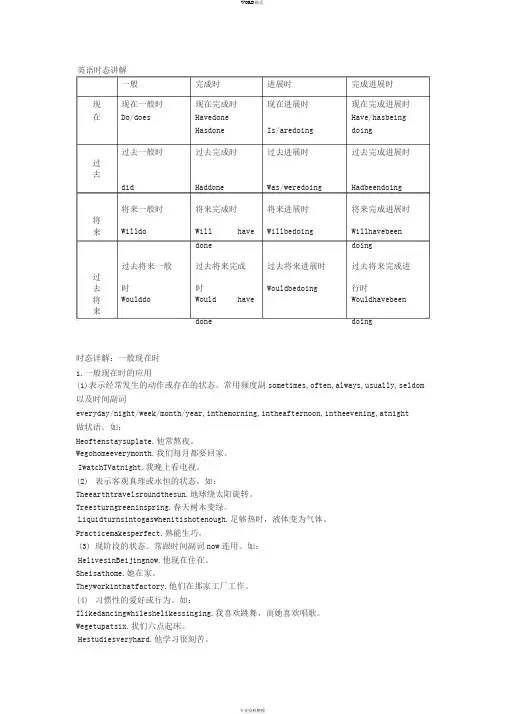
英语时态讲解一般完成时进展时完成进展时现现在一般时现在完成时现在进展时现在完成进展时在Do/does Havedone Have/hasbeingHasdone Is/aredoing doing过去一般时过去完成时过去进展时过去完成进展时过去did Haddone Was/weredoing Hadbeendoing将来一般时将来完成时将来进展时将来完成进展时将Willdo Will have Willbedoing Willhavebeen 来done doing过去将来一般过去将来完成过去将来进展时过去将来完成进过Wouldbedoing去时时行时将Woulddo Would have Wouldhavebeen 来done doing时态详解:一般现在时1.一般现在时的应用(1)表示经常发生的动作或存在的状态。
常用频度副sometimes,often,always,usually,seldom 以及时间副词everyday/night/week/month/year,inthemorning,intheafternoon,intheevening,atnight做状语。
如:Heoftenstaysuplate.他常熬夜。
Wegohomeeverymonth.我们每月都要回家。
IwatchTVatnight.我晚上看电视。
(2)表示客观真理或永恒的状态。
如:Theearthtravelsroundthesun.地球绕太阳旋转。
Treesturngreeninspring.春天树木变绿。
Liquidturnsintogaswhenitishotenough.足够热时,液体变为气体。
Practicemakesperfect.熟能生巧。
(3)现阶段的状态。
常跟时间副词now连用。
如:HelivesinBeijingnow.他现在住在。
Sheisathome.她在家。
Theyworkinthatfactory.他们在那家工厂工作。
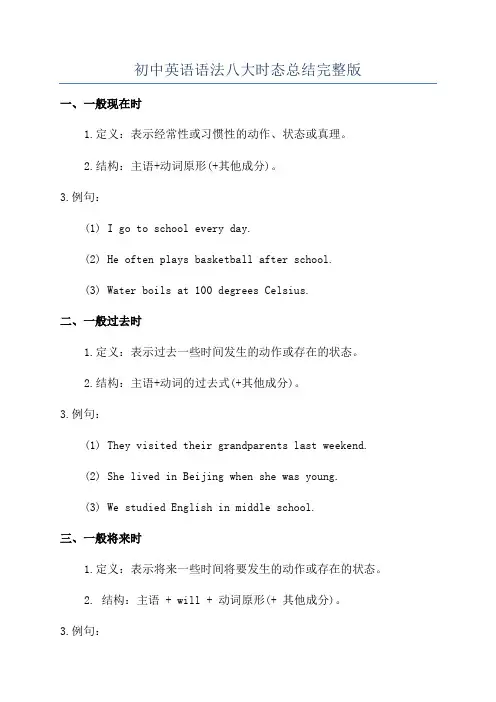
初中英语语法八大时态总结完整版一、一般现在时1.定义:表示经常性或习惯性的动作、状态或真理。
2.结构:主语+动词原形(+其他成分)。
3.例句:(1) I go to school every day.(2) He often plays basketball after school.(3) Water boils at 100 degrees Celsius.二、一般过去时1.定义:表示过去一些时间发生的动作或存在的状态。
2.结构:主语+动词的过去式(+其他成分)。
3.例句:(1) They visited their grandparents last weekend.(2) She lived in Beijing when she was young.(3) We studied English in middle school.三、一般将来时1.定义:表示将来一些时间将要发生的动作或存在的状态。
2. 结构:主语 + will + 动词原形(+ 其他成分)。
3.例句:(1) I will go to the park tomorrow.(3) We will have a party next week.四、现在进行时1.定义:表示现在正在进行的动作。
2. 结构:主语 + am/is/are + 动词-ing(+ 其他成分)。
3.例句:(1) She is reading a book right now.(2) They are playing soccer in the park.(3) We are having dinner at the moment.五、过去进行时1.定义:表示过去一些时间正在进行的动作。
2. 结构:主语 + was/were + 动词-ing(+ 其他成分)。
3.例句:(1) He was watching TV at 8 o'clock last night.(2) They were traveling in Europe during summer vacation.(3) We were studying when the phone rang.六、将来进行时1.定义:表示将来一些时间正在进行的动作。
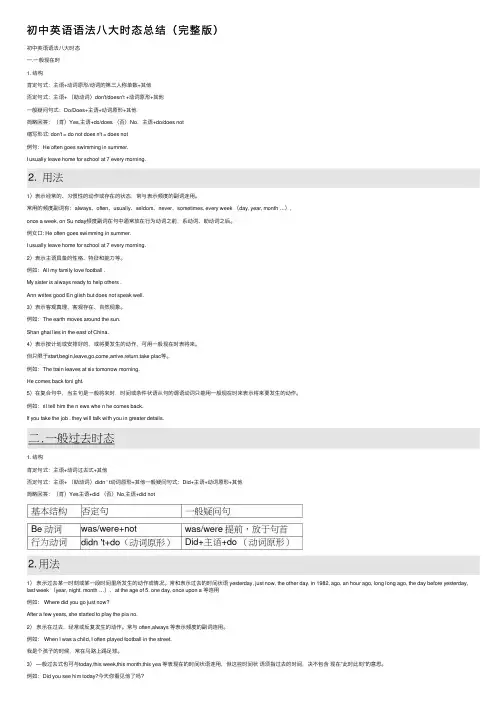
初中英语语法⼋⼤时态总结(完整版)初中英语语法⼋⼤时态⼀.⼀般现在时1. 结构肯定句式:主语+动词原形/动词的第三⼈称单数+其他否定句式:主语+ (助动词)don't/doesn't +动词原形+其他⼀般疑问句式:Do/Does+主语+动词原形+其他简略回答:(肯)Yes,主语+do/does (否)No,主语+do/does not缩写形式: don't = do not does n't = does not例句:He often goes swimming in summer.I usually leave home for school at 7 every morning.1)表⽰经常的、习惯性的动作或存在的状态,常与表⽰频度的副词连⽤。
常⽤的频度副词有:always、often、usually、seldom、never、sometimes, every week (day, year, month …),once a week, on Su nday频度副词在句中通常放在⾏为动词之前,系动词、助动词之后。
例⼥⼝: He often goes swimming in summer.I usually leave home for school at 7 every morning.2)表⽰主语具备的性格、特征和能⼒等。
例如:All my family love football .My sister is always ready to help others .Ann writes good En glish but does not speak well.3)表⽰客观真理、客观存在、⾃然现象。
例如:The earth moves around the sun.Shan ghai lies in the east of China.4)表⽰按计划或安排好的,或将要发⽣的动作,可⽤⼀般现在时表将来。

初中英语基本时态总结Ⅰ、一般现在时1、概念:1)表示经常性或习惯性的动作,常与表示频度的时间状语连用。
时间状语:always, usually, often, sometimes, seldom, never, every day, twice a week, on Sunday, etc.(提问用How often)例:I leave home for school at 7 every morning.Tom gets up at 6:00 every morning.2)客观真理,客观存在,科学事实。
例:The earth moves around the sun. 地球绕太阳转动。
Shanghai lies in the east of China. 上海位于中国东部。
3)格言或警句。
例:Pride goes before a fall. 骄者必败。
注意:宾语从句中,即使主句是过去时,从句谓语是客观真理也要用一般现在时。
例:Columbus proved that the earth is round. 哥伦布证实了地球是圆的。
2、结构:表状态S+ am/is/are+ P (句中有实义动词不用be)表动作S+V原+O (若主语是单三人称,谓动加s/es。
)3、句式变化:变疑问,有be把be提到主语前;无be在主语前加do/does,谓动变为原形。
变否定,有be在be后加“not”;无be在主语后加don’t/doesn’t,谓动变为原形。
例:①They are in the classroom. →Are they in the classroom? Yes, they are./No, they aren’t. →They aren’t in the classroom②He often waters the flowers . → Does he often water the flowers?Yes, he does. / No, he doesn’t. →He doesn’t often water the flowersⅡ、一般过去时1、概念:1)表示在确定的过去时间里所发生的动作或存在的状态。
Eg:1.if i were you ,i would wear a skirt2.what would you do if you had a million dollars ?3.If i had come a few minutes earlier , you would have met him.1、S(主)+ Vi(不及物动词)(谓语)——→主动结构例如:Time flies.1)S + V + 副词(状语)例如:Birds sing beautifully.2)S + Vi + 介词短语(状语)例如:He went on holiday.3)S + Vi + 不定式(状语)例如:We stopped to have a rest.4)S + Vi + 分词(状语)例如:I'll go swimming.2、S (主)+ Vt (及物动词)(谓语)+ O(宾语)——→主动宾结构例如:We like English.3、1)S + Vt + 名词/代词例如:I like music.2)S + Vt + 不定式例如:I want to help him.[说明] 常用于这句型的动词有:decide, hope, learn, need, promise, want, 等。
3)S + Vt + 疑问词+ 不定式例如:I don't know what to do.[说明] 常用于这句型的动词有:ask, decide, find out, forget, know等。
4)S + Vt + 动名词例如:I enjoy living here.[说明] 常用于这句型的动词有:advise, enjoy, finish, mind, practise等。
5)S + Vt + 宾语从句例如:I don't think (that) he is right.[说明] 常用于这句型的动词有:hope, know, notice, think, wonder等。
时态知识梳理动词的时态的知识框架。
一.一般现在时【考点1】一般现在时的用法一般现在时常用时间状语考点3】一般现在时的句式【注:be动词用法歌诀:】英语有个动词be,“面孔”不同要注意;我(I)用am; 你(you)用are, is连着他(he)/她(she)/它(it);主语单数用is,主语复数都用are;变疑问,将be往前提;变否定,be后加not;句首大写莫忘记,句末标点莫丢弃。
【考点4】动词三单变化规律动词第三人称单数变化的规则与可数名词复数变化的规则相同。
二,一般过去时【考点1】一般过去时的用法一般过去时常用时间状语【考点3】一般过去时之be动词1. be动词的过去式形式(表示过去存在的状态)2. be动词的句式变换【考点4】一般过去时之实义动词1. 实义动词的过去式形式规则动词的过去式不规则变化动词的过去式2. 实义动词的句式变换三,一般将来时【考点1】一般将来时的标志一般将来时常用时间状语1. will /shall +动词原形【注:在书面语中,主语是第一人称时,常用shall ,在口语中,所有人称都可以用will;且will 常简略为'll,如:I'll,he'll等】【注:be随着主语的变化有人称和数的变化】arrive, start等。
5. 其他表将来的结构【了解即可】【考点3】will和be going to 的异同点四,现在进行时【考点1】现在进行时的用法现在进行时的常用时间状语现在进行时由“系动词(am, is, are)+ 现在分词(动词加-ing形式)”构成。
【考点4】现在分词的构成【考点5】现在进行时的易错点五,现在完成时【考点1】现在完成时的结构【注:动词的过去分词构成规则】规则变化不规则变化(见附录部分)(需根据不规则变化表进行专门记忆)【考点2】现在完成时的用法和标志1) since+时间点时间副词:【注1:already; yet; just; ever; never; before的用法】【注2:since和for的用法】试比较,判断下列句子的正误。